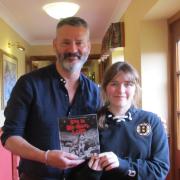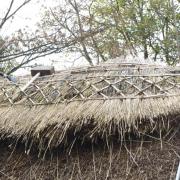
This summer the gardens of South West London were struck by a plague of alien invaders. They hit hard and fast, showing no mercy and left a trail of destruction in their wake. These alien invaders were not creatures from another planet though, they were an aggressive, non indigenous moth that had found its way to the UK from Asia. Their target was the humble box hedge, which provided an ideal nursery for their ravenous offspring.
Cydalima Perspectalis, more commonly known as the box hedge moth, originally came from North China but it was quickly able to spread as infected plants, carrying eggs, were exported commercially. The first indication that these moths had found their way to London, came when small numbers were found in 2011. Since then their numbers have dramatically increased with devastating effect.
The female moths seek out box hedging in early and late summer and lay their eggs, which are then fertilised by the male moth. When these eggs hatch, the caterpillars eat the leaves and produce webbing over the feeding area. To the untrained eye this webbing can easily be confused with that of a spider. The affected area of plant can suffer from severe defoliation and ultimately, is often left unable to recover and dies.
Many gardeners have been left devastated as whole rows of box hedging have been wiped out. Some of these hedges are decades old and will take many years to regrow (assuming they don’t get eaten again). It is not only private gardens that have suffered though. The hedging in many public parks has been left decimated. Strawberry Hill bowling green in Radnor Gardens, Twickenham, fell victim to their vicious onslaught. Almost overnight, the lush green hedge bordering the playing area, was transformed into dead brush wood. Such was the damage that the council were forced to spend two days removing all the hedging. They also had to spray the soil to ensure any surviving eggs were killed off, thus preserving any future planting.
However, it is not all doom and gloom. Gardeners are fighting back by laboriously hand picking caterpillars from hedges, using pesticide sprays and finally through the highly effective use of moth traps. These traps are hung close to the ground next to vulnerable hedging. The traps utilise pheromones which replicate those given off by the female moth. The male moth is attracted to the plastic trap and having entered through a narrow funnel, is left unable to escape.
As winter approaches and the moth activity draws to a close for another year, we are left to ponder what will happen next. Will we be victorious against this alien invader or will the future be privit!






























